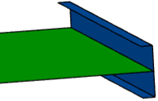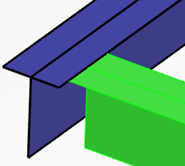What's New | ||
| ||
R2022x FD01 (FP.2205)
R2022x GA
- A new command, Rule-based Copy
 , lets you copy
structural objects along reference planes or create a symmetrical copy of them, with a
freedom of rerouting the inputs using an action rule.
, lets you copy
structural objects along reference planes or create a symmetrical copy of them, with a
freedom of rerouting the inputs using an action rule. - You now have a better control over the specifications of result (new) objects.
- You can easily update new objects if you modify original objects, as a relation link is maintained between them.
- A new command, Structure Resources Manager
 ,
lets you load the structure resources specified in Data Setup, in the active session.
,
lets you load the structure resources specified in Data Setup, in the active session. - For the stiffeners on free edges placed on the boundaries of a panel, you can now specify the default section orientation with respect to the panel.
- A new limit type, Short Weld, is now available. This limit type takes into account the first contact point between a limited profile and a limiting profile.
- You can now select a face of a flange, as a limit for the parametric panel.
- The new Trim options now let you create a flange on the edge of a plate without increasing the overall length of the plate.
- Consistency is maintained between Structure Functional Design and Structure Design models, in drawings for example.
- Flanges can be in contact with other structural elements, for example they can be used as limits for other structural elements. When a Structure Functional Design model is synchronized with Structure Design, you can now avoid clashes.
- The EKL package for Structure Functional Design was updated to include new methods and types, and to enhance a few existing methods.
- The Section Standard, Section Shape, and Section Size attributes now replace the Section Type attribute, to provide precise information on the section of profiles.
- You can now create user-defined end cuts on profiles, using powercopy volume-based end cut references.
- The user interface was improved to guide you while creating structure objects and also restrain you from creating invalid objects.
- You can perform parametric design study on the Structure Functional Design model, to test a number of design variations for potential evolution of an existing design.
Performing Rule-based Structure Copy
Benefits:
For more information, see
Performing Rule-based Copy
Loading Structure Resources in Active Session
Benefits: Loaded resources ensure faster performance of the commands that use
them.
For more information, see
Using Structure Resources Manager
Default Section Orientation for Stiffeners on Free Edges
Benefits: The flange orientation is now computed with respect to the panel. The outward
flange orientation ensures that no stiffeners on free edges clash with the
panel.
New Limit Type: Short Weld
Benefits: Clashes between limiting and limited profiles are avoided.
For more information, see
About Profile Limits
Selecting Flange as a Limit for Parametric Panel
Benefits: You can stiffen a panel effectively by creating a bracket between a flange and
the panel.
For more information, see
Limits
Trim Options for Flange
Benefits:
For more information, see
Creating a Flange
EKL for Structure Functional Design
Benefits: Productivity is improved.
For more information, see
Structure Design Types
Structure Functional Design Functions
Planning Break Report: Providing Precise Information on Profile's Section
Benefits: The report now provides precise information on the section of
profiles.
Creating User-defined End Cuts
Benefits: You can now create end cuts with higher accuracy and
productivity.
For more information, see
Defining PowerCopy Volume Endcut Reference
User Experience Improvement
Benefits: The creation of invalid objects is no longer possible, which improves the user
experience.
Performing Parametric Design Study
Benefits: You can explore a large number of design options by variation in
parameters.
For more information, see
Performing Parametric Design Study on Structure Functional Design Model
- Collaborative Lifecycle: Creating Revisions in the Primary and Secondary Revision Format
- Administrators can now activate a primary and secondary revision format. This format activates a secondary ID, that is incremented every time you create a revision of a non-released object. The primary ID is incremented every time you create a revision of a released object.Benefits: The primary and secondary revision format enables you to differentiate major changes (identified by the primary ID) from design iterations (identified by the secondary ID).
For more information, see Collaborative Lifecycle User's Guide: Creating Revisions and Branches: About Revision Formats.
- 3DEXPERIENCE Native Apps Content Reference Guide
- To help you find the reference information you need to use the content delivered along with your app, you can consult the 3DEXPERIENCE Native Apps Content Reference Guide. For more information, see 3DEXPERIENCE Native Apps Content.




